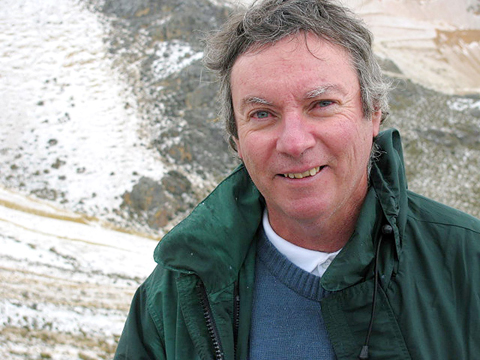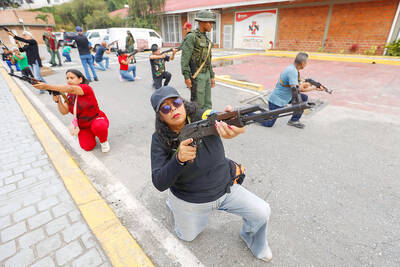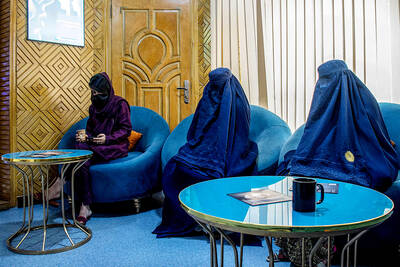In a remote corner of the Peruvian Andes, men in paint-daubed boilersuits diligently coat a mountain summit with whitewash in an experimental bid to recuperate the country’s melting glaciers.
It’s a bizarre sight at 4,756m above sea level. The man behind the idea is not a glaciologist, but an inventor, Eduardo Gold. His non-governmental organization Glaciares de Peru was one of 26 winners of the World Bank’s “100 Ideas to Save the Planet” competition in November last year.
Gold has already begun work while he waits for the US$200,000 prize money to fund his pilot project. His plan is to paint a total area of 70 hectares on three peaks in the Andean region of Ayacucho in southern Peru.

PHOTO: AFP
Chalon Sombrero, the name of an extinct glacier that used to irrigate a valley and several rivers, is where he’s started with a team of four men from the local village, Licapa.
The workers use jugs — rather than paintbrushes — to splash the whitewash onto loose rocks around the summit. So far they have painted some two hectares, just a 10th of the total area they aim to cover on the peak.
“A white surface reflects the sun’s rays back through the atmosphere and into space, in doing so it cools the area around it too,” Gold said. “In effect it creates a micro-climate, so we can say that the cold generates more cold, just as heat generates more heat.”
The idea is based on the simple scientific principle that changing the albedo (a measure of how strongly an object reflects light) of a surface by whitening it means that it does not absorb so much heat and emit infrared radiation, which takes time to leave the earth’s atmosphere and warms trapped greenhouse gases.
US Energy Secretary Steven Chu has endorsed using white roofs in the US to help combat climate change, an idea seen as more logistically feasible than painting mountain peaks.
Gold, who has no scientific qualifications, said: “I’m very hopeful that by doing this we could re-grow a glacier here because we would be recreating all the climactic conditions necessary for a glacier to form.”
In his 65 years, Pablo Parco Palomino has seen the Chalon Sombrero summit turn from an imposing snow-capped glacier into bare rock. Climate change has made life much harder in Licapa, so much so that he believes the scattered population of about 900 may have to move elsewhere.
“All the peaks here should be painted in this way,” he said.
Like him, most of the community welcomed Gold’s pilot project, hopeful that the peak might freeze over again.
“That way there would be as much water as there was before the glacier disappeared and that would mean more pasture to support more livestock,” Palomino said.
Licapa is above the tree line. At more than 4,000m above sea level crops or trees don’t grow. The people live mainly from selling their alpacas’ wool.
Although the project has been awarded funding by the World Bank, scientists have dismissed its contention that it could actually halt or reverse glacial melt.
However, on a small scale it might have an impact, said Thomas Condom, a glaciologist and hydrologist working at the French Institute for Research and Development of Lima, which has been monitoring tropical glaciers in the Andes for the past 15 years.
“It might be possible to slow down a little the melting, to gain a drop of a few 10ths of a Celsius, or maybe one or two degrees Celsius, on a local scale,” Condom said.
However, the temperature and reflected radiation are only two of the factors impacting on the glaciers, he added. Precipitation is another crucial one. Moreover, the project would be very difficult to implement on a large regional scale.
Peru is home to more than 70 percent of the world’s tropical glaciers, but global warming has already melted away 22 percent of them in the last 30 years, according to a World Bank report last year.
Peruvian Environment Minister Antonio Brack has said the World Bank’s US$200,000 in funding would be better spent on other “projects which would have more impact in mitigating climate change.”
“It’s nonsense,” he said bluntly last year.
However, Gold believes he can put the theory into practice and get results.
“I’d rather try and fail to find a solution than start working out how we are going to survive without the glaciers, as if the situation was irreversible,” he said.

BEIJING FORUM: ‘So-called freedom of navigation advocated by certain countries outside the region challenges the norms of international relations,’ the minister said Chinese Minister of National Defense Dong Jun (董軍) yesterday denounced “hegemonic logic and acts of bullying” during remarks at a Beijing forum that were full of thinly veiled references to the US. Organizers said that about 1,800 representatives from 100 countries, including political, military and academic leaders, were in Beijing for the Xiangshan Forum. The three-day event comes as China presents itself as a mediator of fraught global issues including the wars in Ukraine and Gaza. Addressing attendees at the opening ceremony, Dong warned of “new threats and challenges” now facing world peace. “While the themes of the times — peace and development —

Venezuela on Saturday organized a day of military training for civilians in response to the US deployment in the Caribbean, and amid new threats from US President Donald Trump. About a month ago, Washington deployed warships to international waters off Venezuela’s coast, backed by F-35 jets sent to Puerto Rico in what it calls an anti-drug and anti-terrorism operation. Venezuelan Minister of Defense Vladimir Padrino Lopez has accused Washington of waging “undeclared war” in the Caribbean, after US strikes killed over a dozen alleged drug traffickers off his country’s coast. Caracas also accused the US of seeking regime change, and

BRIBERY ALLEGATIONS: A prosecutor said they considered the risk of Hak-ja Han tampering with evidence to be very high, which led them to seek the warrant South Korean prosecutors yesterday requested an arrest warrant for the leader of the Unification Church, Hak-ja Han, on allegations of bribery linked to the country’s former first lady and incitement to destroy evidence. The move came a day after the 82-year-old was questioned over her alleged role in bribing former first lady Kim Keon-hee and a lawmaker. Founded in 1954 by her late husband, Sun Myung Moon, the Unification Church has long been the subject of controversy and criticism, with its teachings centered on Moon’s role as the “second coming” and its mass weddings. Followers are derisively referred to as “Moonies.” However, the church’s

Decked out with fake crystal chandeliers and velvet sofas, cosmetic surgery clinics in Afghanistan’s capital are a world away from the austerity of Taliban rule, where Botox, lip filler and hair transplants reign. Despite the Taliban authorities’ strict theocratic rule, and prevailing conservatism and poverty in Afghanistan, the 20 or so clinics in Kabul have flourished since the end of decades of war in the country. Foreign doctors, especially from Turkey, travel to Kabul to train Afghans, who equally undertake internships in Istanbul, while equipment is imported from Asia or Europe. In the waiting rooms, the clientele is often well-off and includes men